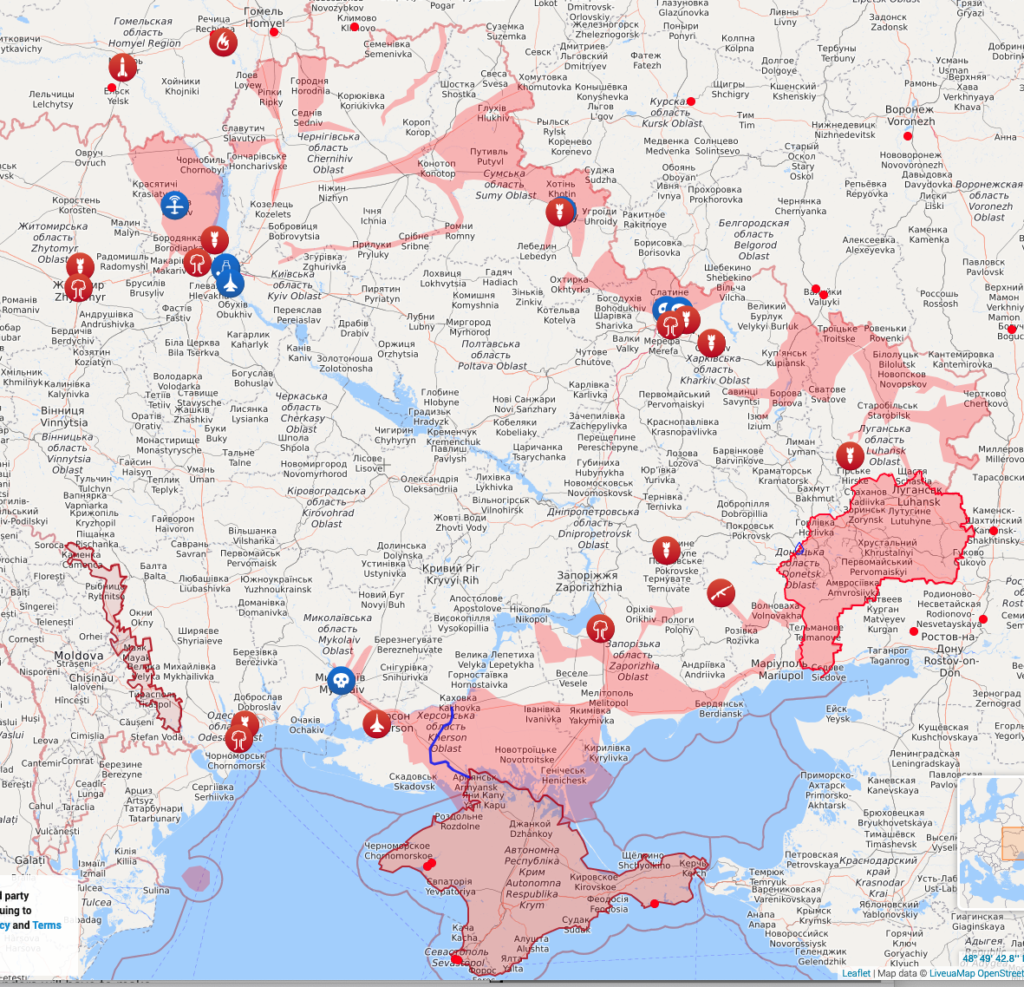A goodly part of the world is pleased about the manifest failure of Vlad’s Big Ukraine Adventure, some are indifferent to it, but only Russia, client-state Syria, and puppet-state Belarus really seem upset about it.
Know who else is bummed? China.
Operation Desert Storm was a turning point in modern Chinese military history. As military planners with the People’s Liberation Army watched U.S. and allied forces make short work of the world’s fourth-largest military (on paper), equipped with many of the same systems as the PLA, it became obvious that China’s quantitatively superior but qualitatively lacking massed infantry would stand no chance against the combination of modern weaponry, C4ISR, and joint operations seen in Iraq. The result was new military concepts and over two decades of often-difficult reforms, which produced the modern, far more capable, “informationized” PLA of today.
Today, the PLA is no doubt closely observing its Russian contemporaries in Ukraine as they under-perform in multiple areas, from failing to take key targets or claim air supremacy to running low on fuel and supplies and possibly experiencing morale collapse, and surely taking away lessons that will shape its own future. Of note, Russia’s experience appears to have confirmed many of China’s recent assumptions behind its investments, such as the utility of unmanned aerial systems in high-intensity conflict, as well as the necessity for the PLA’s 2015 reforms, which aim to fix many of the issues driving Russian failure that the PLA recognizes in itself.
Of the many issues that have contributed to Russia’s physical battlefield woes in Ukraine, one of the most important has been the lack of effective joint or combined arms operations, widely considered essential to any effective modern fighting force. Russia’s poor level of coordination between its various services and branches can only be generously described as incompetent. For example, it has repeatedly failed to provide effective air support to its ground forces or deconflict its air and air-defense forces to avoid friendly fire.
The PLA has long had its own serious issues with joint operations. Traditionally dominated by the Army, the PLA had little success developing a truly joint force until a series of sweeping reforms in 2015 that replaced the former Army-dominated system with a series of joint theater commands. The PLA is thus aware of its own shortcomings and taking steps to fix it, but likely remains far off from being able to conduct truly effective, seamless joint operations. Efforts to conduct joint exercises are becoming more common, but most senior PLA leaders are still relatively inexperienced with joint operations, and even new officers typically do not receive joint education below the corps level. Further, it remains to be seen how far these reforms will go or to what extent they will “stick;” indeed, one reason the PLA did not attempt these reforms until 2015 was because of strong institutional pushback from the Army, whose leaders wished to retain their dominant status.
To China, the Ukraine invasion will reinforce the importance of joint and combined arms operations, while also making clear that such operations are highly difficult to conduct in practice. Russia’s stumbles may give the PLA pause as to whether it is truly ready for all the joint elements that a successful Taiwan seizure would require, including close coordination between sea, air, and land forces.
As well they should be. Russia shares a giant land border with Ukraine, was able to through something like 150,000 troops into the fight, and still got mauled while failing to meet their initial objectives. A giant land border is world’s away from having to conduct fiercely contested landing operations against the heavily defended island of a sophisticated, technological peer foe who’s had over half a century to prepare.
Also, it can’t be encouraging that Russia was unable to hold control of Hostemel Airport during the early stages of the war, since airport seizures for an airbridge into Taiwan has played a large role in many wargamed invasion scenarios.
Some paragraphs on conscript armies and information warfare skipped.
China has also taken note of Russia’s disasterous logistics:
Another ongoing issue has been Russia’s serious problems with poor logistics. The sight of broken-down or abandoned vehicles has become common as Russian forces run out of fuel and other vital supplies. To its credit, the PLA has also been rapidly reforming and modernizing its logistical system as part of the same broad set of 2015 reforms. As part of these reforms, the PLA has emphasized its logistics organizations and created the Joint Logistics Support Force. This force’s training has focused on cooperation with other branches of the PLA, and it has cut its teeth training to establish supply lines during natural disasters. In 2018, the JLSF launched its first major exercise, dubbed “Joint Logistics Support Mission 2018,” featuring medical drones, helicopter-dropped refueling depots, and operations in harsh and remote terrain.
Hey, remember all that stuff I said about long land borders vs. amphibious and airborne invasion? It applies double (if not quadruple) for logistics. China can’t assume it will have complete air and sea control of the Taiwan strait, and it’s really hard to run an invasion if you’ve run out of ammo, food and fuel.
However, while the outward manifestation of many of the issues faced by the Russian military appear to be logistical in nature, the true heart of the issue may be corruption. There are reports that before the invasion Russian military officers sold off their fuel and food supplies, and that these corrupt practices may be responsible for the stalling of a Russian tank column outside Kyiv. In this regard, the PLA has much to fear. Corruption has plagued the PLA for decades, with some PLA officers bluntly stating in 2015 that it could undermine China’s ability to wage war. Reportedly, more than 13,000 PLA officers have been punished in some capacity for corruption since Xi Jinping took power, including more than a hundred generals. This was a particular problem in the logistics sector, where there are more opportunities for corruption and links to the civilian economy.
Yet, despite the reorganization of the PLA and widespread prosecution of corruption cases, it still appears to be a major issue. Anti-corruption efforts are ongoing, with Chinese Gen. Zhang Youxia recently calling for innovative measures to keep up the fight. But the fact that Fu Zhenghua, the man brought in to take down the corrupt former security chief Zhou Yongkang, is himself now under investigation for corruption does not bode well for the long-term effectiveness of China’s efforts. The troubled invasion of Ukraine provides a stark real-world example to Xi, the CCP, and PLA about the impact corruption can have on military effectiveness, and will no doubt cause them to redouble their anti-corruption efforts with a newfound urgency. However given its similar authoritarian system and emphasis on career advancement through patronage, systemic corruption may be baked into the system.
China without corruption is like Norway without snow.
But not everything is that’s made life difficult for Russia will apply to China.
While China will benefit from Russia’s increasing reliance on its goods and services, Beijing can be expected to retool its geo-economic strategy to reduce its vulnerability to a similar nightmare scenario. For example, it will likely redouble its efforts to promote its Cross-Border Interbank Payment System—an alternative to the SWIFT international banking system—among its strategic partners and foreign aid recipients in the developing world.
Likewise, China’s recent “Dual Circulation” economic strategy appears to be aimed at countering a decoupling from China’s trade partners. Further, Beijing has surely observed how easy it was for corporations to withdraw from Moscow. If China is to be exposed to the risk of global sanctions and corporate withdrawal, so too are countries and corporations exposed to dependence on the world’s second-largest economy, and thus the government will likely take efforts to make any sanctions or corporate turn against China as painful a prospect as possible. Either way, policymakers in Washington need to understand that the sanctions being used today against Russia are unlikely be as effective the next time around, as China is not just a different economy, but also will learn from the current conflict and adjust accordingly.
This is undoubtedly true, and China has a much broader and more modern economic and industrial base with which to wage war. All the more reason for America to bring critical manufacturing and other economic business outsourced to China back home.
For all these valuable lessons, there is little doubt that China has been watching the ongoing conflict with no small amount of chagrin. Chinese leaders are reportedly surprised and unsettled by the poor military performance of its Russian partners, Ukraine’s resistance, and the level of solidarity from the international community. The image of a much smaller state, against all odds, successfully resisting a larger neighbor surely sits uneasily in the psyches of CCP apparatchiks and PLA officials. It also counters the narrative of overwhelming force and grim inevitability Beijing has sought to instill in the psyches of the Taiwanese people. It is notable that early attempts by Chinese state media to capitalize on the Ukraine invasion in precisely this fashion, illustrating how the United States will surely abandon Taiwan when the chips are down, quietly ceased after the initial days of the war, when it became apparent that the U.S. was not, in fact, abandoning Ukraine. Beyond purely psychological factors, Ukraine also offers a blueprint for successful resistance via asymmetric warfare very similar to Taiwan’s proposed Overall Defense Concept, perhaps giving a jolt to a plan that most analysts agree offers Taiwan its best chance of success against the PLA but has stalled out in the face of bureaucratic resistance.
While China and the PLA will surely watch Ukraine closely and try to take away the correct lessons, there is one uncomfortable parallel which China may be unable to avoid by the very nature of its authoritarian system. The runup to the Ukraine invasion featured multiple strategic miscalculations by Putin, driven at least in part by him surrounding himself with the yes-men who inevitably cling to authoritarian leaders, eager to please and afraid to speak truth to power. This was obvious in the visibly uncomfortable reaction of Russia’s SVR (foreign intelligence) chief as he was publicly pressured to agree with Putin in the days leading up to the war, as well as in the sackings and arrests of multiple military and intelligence officials after the war turned poorly. Authoritarian leaders have systemic problems in gaining reliable intelligence, oftentimes magnified by their overconfidence in their own singular understanding of a situation. As China continues its slide away from a system of intra-Party consensus toward a one-man cult of personality in which dissenting views are increasingly unwelcome, Xi is bound to encounter the same problem. It is unclear whether Xi will learn this lesson from Putin, or make his own similar miscalculations in the future towards China’s own neighbors.
Dictatorships (especially communist dictatorships) greatly increase the possibility of a “Thermocline of Truth” building up between bad news and fawning yes-men fearful of making the dictator angry. There’s very little reason to believe that Xi Jinping’s chain of command suffers from the problem any less than Putin’s.
In war, comforting lies will get your ass kicked.

